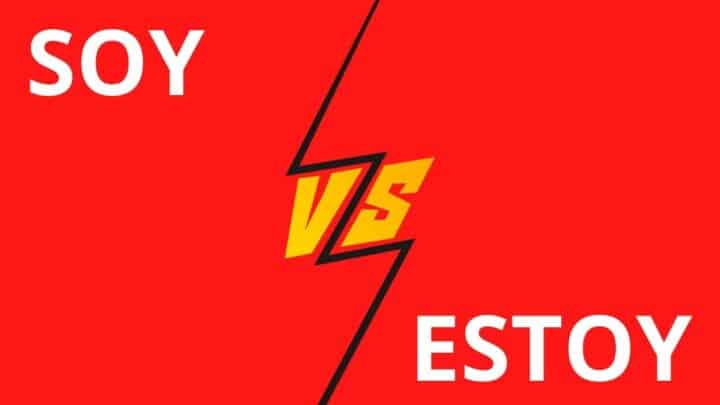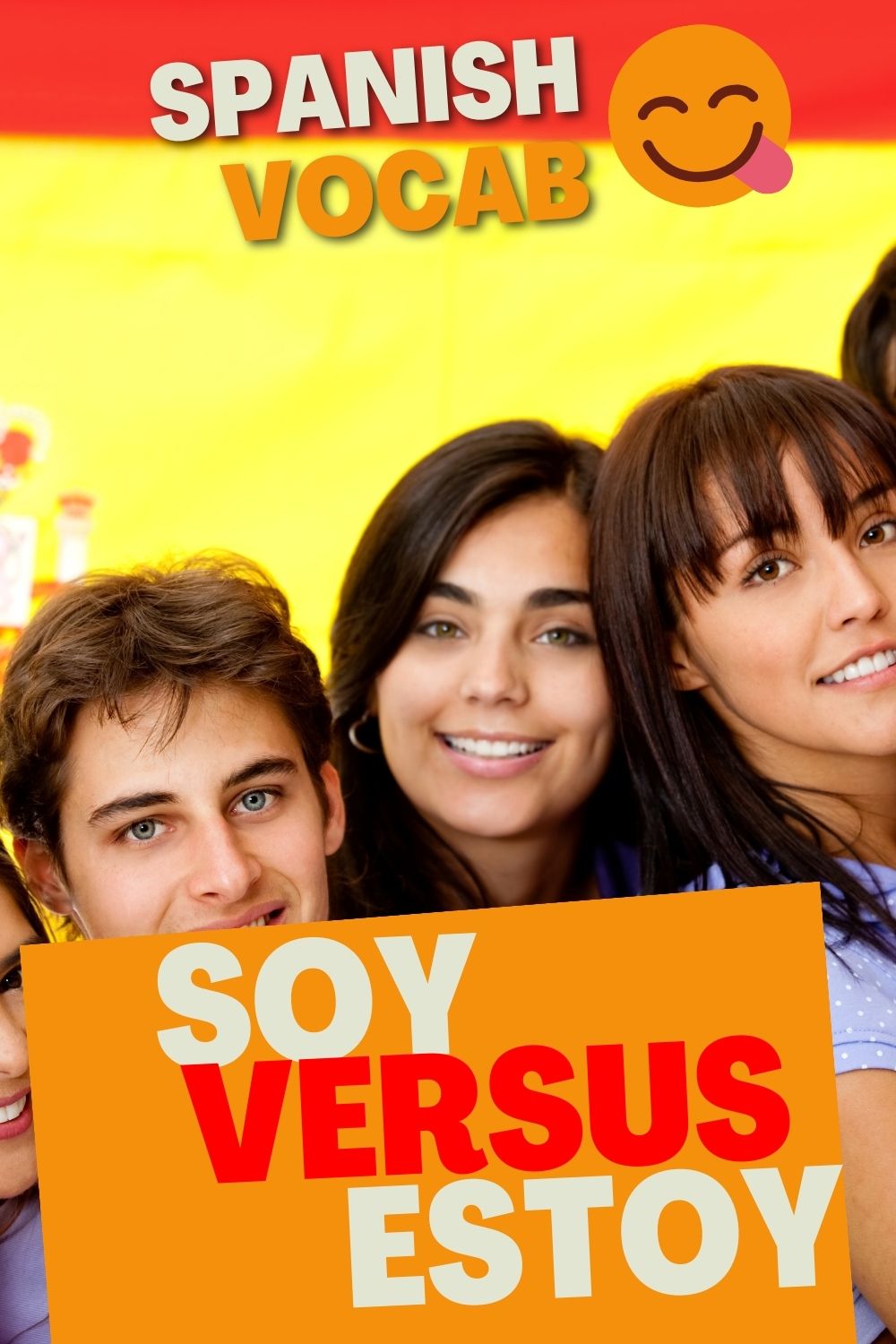Spanish has lots of pairs of words that have similar meanings (or, when translating into English, are the same word) but which are slightly different.
These pesky pairs include ‘saber’ and ‘conocer’ (to know), ‘ir’ and ‘irse’ (to go and to leave) and ‘pedir’ and ‘preguntar’ (to ask.)
One of the first pesky pairs we encounter in our Spanish studies is ‘soy’ and ‘estoy’ (I am).
So, if you’re finding it a challenge to know when you should say ‘soy’ (I am) and when you should say ‘estoy’ (I am) then worry no more!
This blog post will teach you the key differences between these two very important verbs.
Let’s start with a quick overview of the differences.
What is the difference between “soy” and “estoy”?
“Soy” and “estoy” are both first-person present tense conjugations of verbs meaning ‘to be.’ That is to say, they both mean ‘I am.’ “Soy” is used when you’re talking about permanent, unchanging or rarely changing things. “Estoy” is used when you’re talking about things that do vary regularly.
How to use soy
Soy means ‘I am’ when talking about permanent or long-lasting attributes.
As a rule of thumb, we can use the acronym DOCTOR to help us remember when to use soy:
- Descriptions
- Occupations
- Characteristics
- Time
- Origin
- Relationships.
Descriptions
Descriptions include things such as names, physicality, nationality and personality. These are things that are generally permanent (or, at least, that we assume won’t change in the near future!)
Let’s look at some examples of descriptions.
Examples:
Soy Manuela | I am Manuela
Soy alto y atractivo (m) | I am tall and attractive.
Soy pequeña y forte (f) | I am small and strong
Soy estadounidense. | I am American (from the USA).
Soy católico. | I am Catholic.
Occupations
For the purposes of our acronym, an occupation is what you do for a living or your hobby. Pretty much any way that you spend time uses soy.
Examples:
Soy estudiante de español. | I am a student of Spanish.
Soy actriz. | I am an actress
Soy piloto. | I am a pilot
Characteristics
Characteristics are descriptions of your personality. It’s an extension of the idea of ‘descriptions.’
Examples:
Soy romántico y fiel. | I am romantic and trustworthy.
Soy inteligente y ambiciosa. | I am intelligent and ambitious.
Soy simpático y cómico | I am nice and funny.
Time
Time refers to days of the week, months of the year, and the time of day.
Be careful, because when we talk about our age, we don’t use ‘soy.’ We use ‘tengo.’ So you probably won’t be using ‘soy’ for any of these, but you can use other conjugations of the verb ‘ser’.
Origin
Origin refers primarily to where someone or something is from. It can also mean the material something is made from (using ‘es’ or ‘son’ rather than ‘soy).
Examples:
Soy de España. | I am from Spain.
Soy de México. | I am from Mexico.
Mi abrigo es de cuero. | My coat is made of leather
Relationships
Any personal relationships (family, friendship, romantic relationships etc) are also discussed with soy.
Examples:
Soy tu padre. | I am your father.
Soy tu novio. | I am your boyfriend.
Soy tu subalterno. | I am your subordinate.
When to use “estoy”
Estoy is used to talk about temporary states and locations.
The acronym PLACE is commonly used by Spanish learners to help us remember when to correctly use estoy.
Position Location
Action
Condition
Emotion.
Position
Position refers to the physical position or posture you are in.
Examples:
Estoy sentada. | I am sitting down.
Estoy en medio de algo | I’m in the middle of something
Location
Your location refers to where you physically are. Unlike the other uses of estoy, which are temporary, this could also be permanently or theoretically.
Examples:
Actions
Estoy is combined with the present participle to describe ongoing actions. This is just like the English construction “I am doing something.”
Examples:
Estoy barriendo el suelo. | I am sweeping the floor.
Estoy sacando la basura. | I am taking out the trash.
Estoy pasando la aspiradora | I am vacuuming
Conditions
Physical and mental conditions are described using estoy. Things that are likely to change over the course of hours, days, or even years can fall into this category.
Examples:
Estoy cansada esta mañana. | I am tired this morning.(I might not be tired this afternoon, or tomorrow morning.)
Estoy enfermo hoy. | I am sick today. (But hopefully not forever!)
Emotions
How you are feeling is also described using estoy. This is related to conditions because your feelings are likely to change over time.
Estoy contenta. | I am happy.
Estoy nervioso. | I am nervous.
Estoy triste. | I am sad.
Why is it important to know the difference between soy and estoy?
As well as helping you to sound fluent, knowing the difference between soy and estoy can stop you from accidentally saying something you don’t mean.
Some words can be used with either “soy” or “estoy”, and they change their meaning depending on the verb you use.
How to use soy and estoy in a sentence
soy aburrido. | I am boring.
estoy aburrido. | I am bored.
soy bueno. | I am good.
estoy bueno. | I am attractive.
soy cansado. | I am tiring to be around.
estoy cansado. | I am tired.
soy grave. | I am serious.
estoy grave. | I am seriously ill.
soy listo. | I am clever.
estoy listo. | I am ready.
soy malo. | I am a bad person.
estoy malo. | I am ill.
soy orgulloso. | I am vain.
estoy orgulloso. | I am proud.
soy pesado. | I am heavy or I am boring.
estoy pesado. | I am annoying.
soy seguro. | I am safe.
estoy seguro | I am certain.
soy viejo. | I am old.
estoy viejo. | I look old.
Conclusion
As you can see, the differences between “soy” and “estoy” are subtle but very important to make sure you can be understood fully.
But don’t worry. While it might be challenging at first to have to think about which version of “I am” you want to use, the more you practise the easier it gets until, eventually, you will no longer have to think about it!

Hey fellow Linguaholics! It’s me, Marcel. I am the proud owner of linguaholic.com. Languages have always been my passion and I have studied Linguistics, Computational Linguistics and Sinology at the University of Zurich. It is my utmost pleasure to share with all of you guys what I know about languages and linguistics in general.


